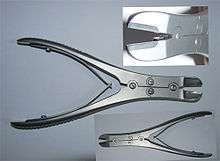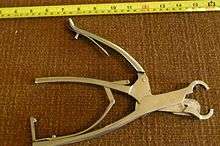Bone cutter
A bone cutter is a surgical instrument used to cut or remove bones. In addition to surgery, they are also used in forensics, torture, and dismemberment.

A bone cutter
Types of medical bone cutters include:
- Unpowered – Unpowered bone cutting implements include varieties of hacksaw and sabre saw. In many applications, the saw is used in specialised jigs to provide accurate, measurable cuts, e.g. in knee surgery. Specialized saws such as the Gigli saw, a cable made of sharp strands of wire, are also used in some procedures.
- Reciprocating – Usually a powered rotary oscillation is applied to a specialised cutting implement to provide smooth controllable cuts into bone, for applications, from skull cutting to rib cutting. A sternal saw is a reciprocating bone cutter.
- Sonic (or sound cutting) – The sonic cutter is still experimental, but its primary focus is to use high frequency, high amplitude sound to remove material (in this case bone), providing the ability to cut. Some tissue sonic cutters are being produced.

A costotome in the open position
See also
References
- http://samhs.org.au/Virtual%20Museum/Surgery/costotome/costotome.html
- Kapur, MM (January 1, 2008). Introduction to Surgical Instruments and Procedures. Elsevier India. pp. 15–16. ISBN 9788131216064.
This article is issued from
Wikipedia.
The text is licensed under Creative
Commons - Attribution - Sharealike.
Additional terms may apply for the media files.